Pottery – from earth to the table
As part of our vision to help revive and spotlight Arabian and Middle Eastern artisanal crafts, we at Middle East Business News and Magazine regularly feature handmade products and processes. In previous issues we’ve featured leather tanneries, argan oil production and traditional wooden boat building. We now turn our focus to a handmade product that is featured in every home and often a souvenir brought back from overseas – pottery.
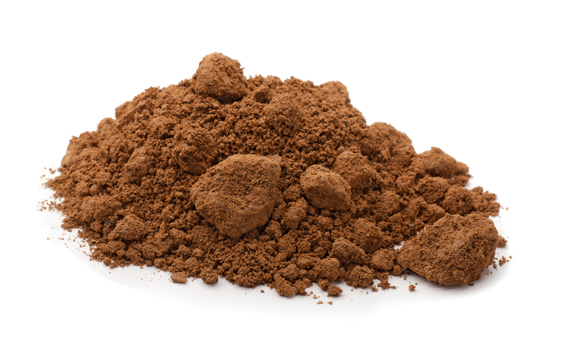
Decorated pottery is not usually the most highly regarded or expensive of the arts in many cultures (save perhaps for China), but is very widely made and used. Since time immemorial, ceramics have been one of the objects that mothers used to pass to their daughters to symbolise the wealth and originality of their family.
Moreover, many families used to consider – and many still do – that their ceramic tableware is part of their wealth and use it only for special occasions. Pottery breaks, but it does not decay, rust or rot, and it cannot be recycled. It therefore survives in large quantities where other materials have disappeared.
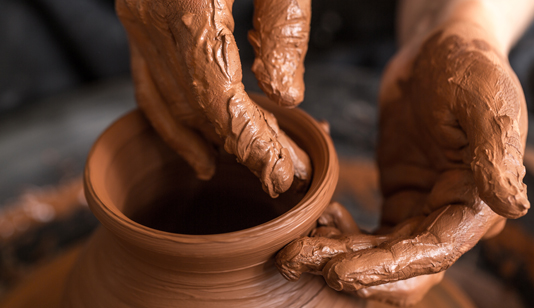
Pottery can be used to follow technical developments, to understand fashions in style, to judge economic activity and to track trade across the continents. One element that connects each of the subjects we have looked at as part of this series of articles is the enormous amount of manual labour and effort that goes into creating each artisanal product. Each end product reflects the physical labour (hopefully not blood or tears!) of the craftsperson involved.
Though not as toxic as the tanning of leather, pottery is another artisanal work that takes a lot of effort and requires real muscle. But what is different with the pottery industry is that its still a vibrant sector and employs many people across our region. To make a perfectly fabricated pot that is good for export, many people are involved at each stage to ensure quality. A lot of development has taken place to perfect these processes and the sector has advanced throughout history … isn’t it time we showed our appreciation of it?
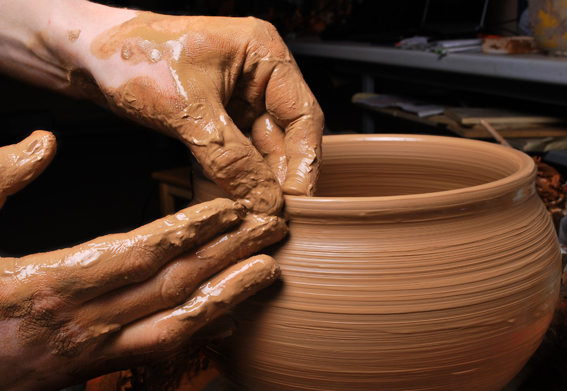
Historical overview
Unglazed pottery had been extensively made everywhere in the Middle East before the Islamic conquests. In early Islamic times there was a boost in production of all types of wares, from coarse unglazed storage- and cooking-wares to finely decorated tableware.
The main kind of glazed ceramics made in the Middle East immediately prior to the Islamic period were green-blue glazed domestic, storage and transport wares, which continued to be made in the following centuries. However, by the AD 800s glazed wares proliferated over the entire Islamic world showing considerable variety and invention in decoration and technology.
Pottery is considered as a reflection of social, economic and environmental conditions and is a significant indicator of a society’s cultural development.
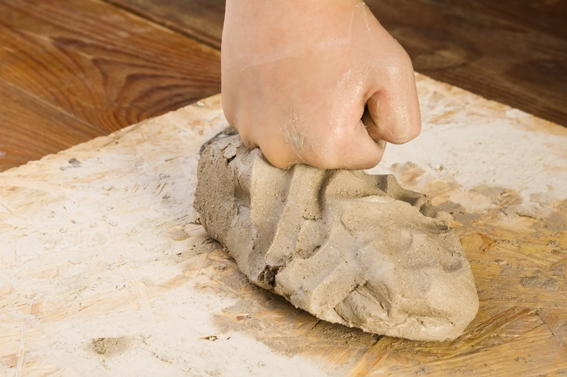
According to US newspaper, The New York Times, fragments of ancient pottery found in southern China dates back 20,000 years, which is 2 – 3,000 years older than examples found in East Asia and elsewhere. On the other hand, plant cultivation in the Middle East arrived about 1,000 years before it did in China. Still, pottery was not used in the Middle East until much later.
The earliest containers used by Neolithic man were made of carved stones or wood or animal skins, and baskets were made from branches or parts of plants. But baskets couldn’t hold liquids nor heat, that’s why a cheaper and more available material started to be used: clay.
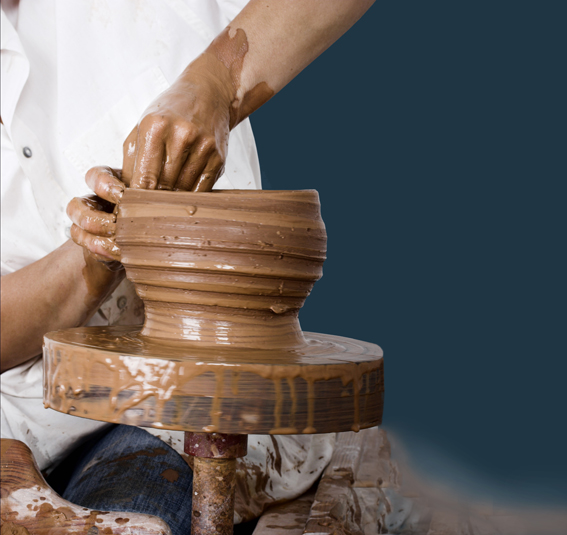
Modern pottery is made of the same reddish brown clay as it was in ancient Egypt where the poorer people used to manufacture small lamps, dolls, toy animals, ships and the like, while their games were sometimes played on pottery game boards with clay pieces. Evidence of this has been found in the numerous excavations across time.
What Types of Pottery Are There?
There are three types, depending on the type of clay used and the temperature required to fire them.
Earthenware: This is the oldest and easiest type of pottery to make. It is also the softest, being heated at the lowest temperature. Its colour ranges from buff to dark red
Stoneware: This needs to be coated with a glaze, as it’s more dense and needs a higher temperature in the oven. Colour ranges from gray to buff.
Porcelain: This is the finest grade of pottery and most difficult to perfect. Chinese and Japanese porcelains are rated highly by collectors and thus attract a higher value, especially for ancient examples.
Pottery in the Middle East
The development phase
In any industry or fabrication process, there is a need for basic elements. In the case of pottery, two main elements made the course of history different for our pottery:
Fire
The most important of all of mankind’s inventions is fire. A turning point came when the first kilns (or simply a hole in the ground with fire) appeared around 6000 BCE in the Middle East so the pots became more important to society as they were of better quality and able to have wider use.
The wheel – 3000 BC
It is almost impossible to make a perfectly round pot by hand without the use of a specialised tool. By about 3000 BC (some sources mentioned Between 6000 and 4000BCE) a simple revolving wheel became part of the potter’s equipment, invented in Mesopotamia (Iraq, Kuwait, Syria region), and which enhanced this industry by allowing it to develop new products. The fabrication of pottery became associated with more urban environments, as materials were more readily available than areas such as the desert with predominantly Bedouin populations. The main use of pottery during this era was to hold liquids – particularly water – as it was thought that it was healthier if drunk from a clay jar as it is kept cooler.
Influences from across the globe
According to the University of Oxford’s Ashmolean Museum, trading contacts with China in the late AD 700s resulted in the import of large quantities of high-fired white wares to the Islamic world. These probably arrived acting as ballast in ships carrying spices and silk. Chinese wares were greatly valued in our region – nothing as fine, hard and white had been seen before. Inspired by these items, Islamic potters in Iraq started to make copies in a soft earthenware covered with a tin-based, opaque white glaze. They soon began to add to their pieces an original decoration in new techniques.
For over 500 years, Islamic potters used simple materials and techniques to make a range of decorated luxury pottery. The final appearance of these pots varies enormously, but all are made by simple tweaks to the same basic technique. Vessels in red clay were covered in a white slip (a fine clay diluted to a creamy texture). The decoration could then be carved through the slip, or patterns in coloured slips applied. Finally, a thin layer of glaze (a glassy coat), which could be left transparent, or stained with metal-oxide colours was applied.
The arrival in the 1100s of a new kind of Chinese porcelain set the Islamic potters off in a new direction. These were exquisitely thin and had delicate incised or moulded decoration. Potters in the Islamic world were unable to make successful copies until they developed a type of fine ceramic known as fritware (or stonepaste). Largely made of ground quartz, this material was pure white, could be fashioned into thin-walled vessels, and was covered with a brilliant transparent glaze. Incised, moulded and painted decoration was creatively applied to the new body in the region stretching from Egypt to Syria and Iran.
From about 1170 to 1220, Iranian potters in the town of Kashan used the newly introduced ‘fritware’ ceramic to make refined and sophisticated pottery. These finely made pots were decorated with elaborate and detailed images painted in lustre – a technique in use in the Islamic world since the second half of the AD 800s – or with the newly developed method of overglaze enamel painting (mina’i). Lustre-decorated pottery was made at the same time in Raqqa and in other manufacturing centres of historic Syria.
Enamel-painted wares are one of the achievements of Iranian potters of the late 1100s and early 1200s. Like lustre, this technique required two firings in order to fix the enamels (usually red and black) and the occasional gold. This process made the manufacture more expensive and the risk for the objects higher. To date, Kashan, Iran, is the only identified centre of production of these wares.
Mongol period
The Mongol armies of Genghis Khan invaded China and swiftly moved through Central Asia into the Islamic heartland in the 1220s. By mid-century, they had occupied a vast area extending from the Caucasus to Central Asia. Political stability in the region was restored in the second half of the century, allowing intense trade and exchange throughout Asia.
The Islamic pottery of this period is distinguished by its robust shape, often sombre colouring and new motifs. Chinese patterns such as lotuses, phoenixes and dragons were copied from textiles and other objects arriving from the Far East.
Chinese influence
For the third time in Islamic history, a new wave of Chinese pottery reached the Middle East in the 1300s and transformed again the nature of Islamic ceramics. Chinese porcelain decorated in cobalt blue (‘blue-and-white’ ware) started to be made in the kilns of Jingdezhen around the 1320s, largely for export. From the 1400s onwards, Islamic potters devoted great effort into making copies and imaginatively of blue-and-white porcelain.
The 1600s saw a boom in the production of ceramics to supply the burgeoning Iranian cities made rich on manufacturing and trade. However, other wares produced in this period broke away from the Chinese model and used fully Islamic techniques and patterns. Lustre painting enjoyed renewed popularity after three centuries of decline, while carved and moulded vessels continued to be made alongside underglaze and slip-painted wares.
Ottoman empire
At the peak of their power in the 1500s and 1600s, the Ottomans ruled over a vast empire that reached across Europe into the Middle East and beyond. From the late 1400s, potters at Iznik in Ottoman Turkey had begun to develop a unique and refined kind of ceramics, which served both the court and the market. They employed a frit body rich in lead, and developed vibrant new colours. To the initial blue and white, they gradually added turquoise, green, purple and the distinctive bole-red, which remained in relief.
Is it healthier to drink water (and cook) from clay pots?
Elders in the Middle East – especially in the rural areas – were convinced of the benefits of drinking water from clay pots.
This theory still exists today: on their website, UNESCO mentions the use of locally produced clay pots modified for safe storage of drinking water in the home as a component of CARE Kenya’s ‘Healthy Water Project’. It says, “Traditionally, as in many parts of the developing world, people in these communities have stored drinking water in locally produced wide-mouth clay pots. The baseline survey indicated that over 90% of the residents use these pots, which have an evaporative cooling effect on the water, thus the high preference”.
Here are some associated benefits to entice you to use clay/pottery vessels:
Cooling: Clay pots not only cool the water down, some people believe it can provide healing with the elements of earth. Its unique composition makes it transfer the chill to the water, based on the climate.
Porous: If you store water in a clay pot, an evaporation process happens which cools the water, so particles gain energy in the form of heat, then change to gas and get mixed with air. Water seeps out through the pot’s pores and gains energy to become gas and is evaporated causing cooling.
pH Balance: Clay, being alkaline, helps neutralise the pH balance of food by interacting with the acid present in the food.












